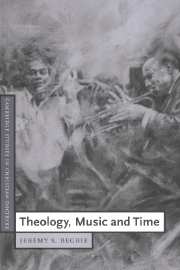Book contents
- Frontmatter
- Contents
- List of musical examples
- List of figures
- Acknowledgements
- Part I Introduction
- Part II In God's good time
- 3 In God's good time
- 4 Resolution and salvation
- 5 Music, time and eternity
- 6 Repetition and Eucharist
- Part III Time to improvise
- Bibliography
- Index of names
- Index of biblical verses
- General index
4 - Resolution and salvation
Published online by Cambridge University Press: 05 June 2012
- Frontmatter
- Contents
- List of musical examples
- List of figures
- Acknowledgements
- Part I Introduction
- Part II In God's good time
- 3 In God's good time
- 4 Resolution and salvation
- 5 Music, time and eternity
- 6 Repetition and Eucharist
- Part III Time to improvise
- Bibliography
- Index of names
- Index of biblical verses
- General index
Summary
The word of promise … always creates an interval of tension between the uttering and the redeeming of the promise. In so doing it provides man with a peculiar area of freedom to obey or disobey, to be hopeful or resigned.
Jürgen MoltmannIn this chapter we aim to ‘think together’ musical process and some major themes in eschatology. Whatever else ‘eschatology’ may mean, it bespeaks a future-directedness in the Christian faith, an orientation towards a fulfilment of the purposes for which God has brought all things into being. Seen from the point of view of salvation, this orientation is intensified, for now it focuses on a resolution of the corruptions and dislocations of the world.
The ground for this chapter has already been laid in chapter 2. There we found that music was characterised by a teleological dynamic, marked by multi-levelled patterns of equilibrium, tension and resolution. Creation–fall–redemption may well come to mind in this connection, a huge metrical wave occasioned by the crises of evil and sin, within which are nested a multitude of smaller waves of divine activity at different levels. In the New Testament, the pattern is probably enshrined most memorably in the so-called parable of the prodigal son (Lk. 15:11–32). It is perhaps not surprising that the kind of music we are considering germinated and grew within a predominantly Christian setting.
- Type
- Chapter
- Information
- Theology, Music and Time , pp. 98 - 127Publisher: Cambridge University PressPrint publication year: 2000



